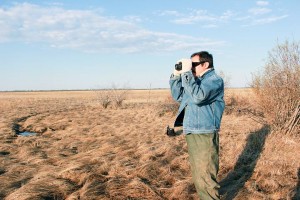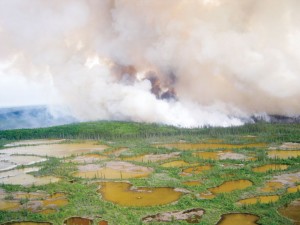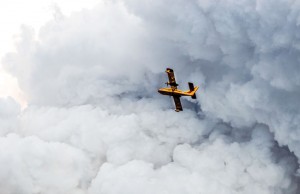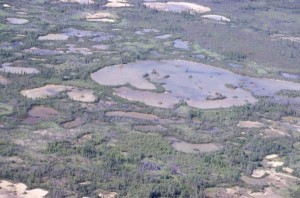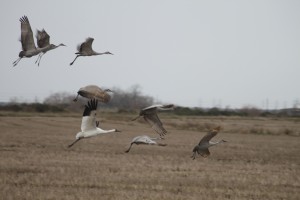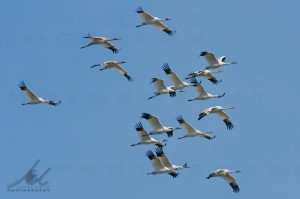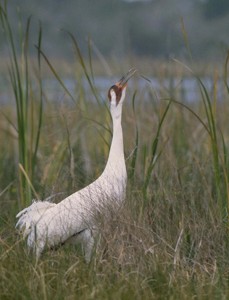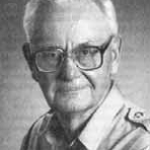Archive for the ‘Census Flights’ Category
Fort Smith man stands on guard for whooping cranes – Canadian Wildlife notes whoopers expanding nesting range
June 25, 2013by Renée Francoeur, Reporter, The Northern Journal, Fort Smith, NT, Canada
His mission – completely voluntary – is to watch over the tallest birds in North America, the whooping cranes, which nest in the area after a 2,500-mile summer migration from Texas.
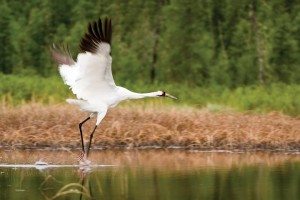
Photo by Photo: Klaus Nigge – An elegant whooping crane swoops across a wetland.
“They’re my passion and I want to help protect them. You can’t see this anywhere else,” said Schaefer, a town bylaw officer and Salt River First Nation councillor.
Canada is home to the world’s largest migratory population of whooping cranes. According to Environment Canada, there are almost 300 birds in the Wood Buffalo flock – the only self-sustaining, wild flock on earth.
Whooping cranes were designated as endangered in Canada in the year 2000. It was estimated by the Whooping Crane Conservation Association that only 16 whooping cranes were left on the entire planet in 1941-1942.
“I was probably 14 when I saw my first whooper. I was out hunting birds at Foxholes. When I came to realize these were endangered birds, I just wanted to take care of them,” Schaefer said. “I want to share what I know and see with others so we can come together to help preserve their habitat.”
Schaefer has named the two young cranes he’s been keeping an eye on Snowball and Snowflake, who he thinks are descendents of the original “Lobstick pair,” which still nest further down on the Foxholes prairie land.
Canadian Wildlife counts 74 nests in 2013
Many cranes make their nests in the traditional breeding grounds in the northeastern corner of Wood Buffalo National Park. Their nests are counted every year for a survey by the Canadian Wildlife Service, undertaken in partnership with Environment Canada and Parks Canada.This year, 74 nests were counted, according to Mark Bidwell, a species at risk biologist with Environment Canada. That number is one less than the record set in 2011 at 75.
“Counting the nests gives us an idea of how the birds are doing and it helps us track their movement,” he told The Journal. “The number of nests goes up and down from year to year, but over long periods of time, it’s continuing to tick upwards. That’s a positive.”
Bidwell estimates about 150 birds are breeding out of the 300 in the flock.
As well, Bidwell noted, the population continues to expand outside the park. Eight nests were discovered outside Wood Buffalo’s perimeters this year – one more than ever recorded. Additionally, breeding pairs, known to go back to the same nest year after year, are making nests in new locations, never before monitored by surveyists. Four to six new nests were recorded this year.
“What this means is the population is moving increasingly into areas that are not formally protected. It’s not a critical situation yet as most birds are still using the park and the ones using areas outside the park, those locations are still quite remote. In Texas, however, where they spend the winter, it’s different and they are coming into more contact with people and development.”
More possibilities of human interaction with the cranes also worries Schaefer.
“Almost every long weekend there are people out quadding in this nesting area at Foxholes,” he said. “On the May long weekend, a big group was headed right for the nest and if I hadn’t been here to stop them, they’d most likely have run right over it…There’s this perception, you can go quad anywhere. You can’t. This is a restricted area. I put big ‘Whooper Warning’ signs up to keep people away from them, but it doesn’t seem to be working.”
Sonia Trudeau, who went out with Schaefer to see the cranes last month, said she cried when she saw the eggs.
“That is something no one gets to ever see. It’s so special. I’ve lived here in Smith all my life and never seen that,” she said. “More people need to be aware of where the nests are. We need to protect them and their habitat or they won’t be here one day.”
The Canadian Wildlife Service will return to the Fort Smith area in August to do a follow up survey on the nesting success and chick productivity.
“Typically, 40 to 50 per cent of the nests we found in May will have chicks survive. That’s not as bad as it sounds for a big-bodied bird who can live up to 20 years,” Bidwell said. “While most pairs lay two eggs, usually only one chick survives. Sometimes there are both, though, depending on the year and resources.”
Meanwhile, Schaefer said he plans to keep a close eye on Snowflake and Snowball’s rusty-brown coloured chick, who just hatched last week.
“They know me. I can read them. I know when to back off when they’re in protective mode. I think they know I’m looking out for them,” he said.
Salt Mountain burns as Mother Nature has her way
June 18, 2013by Don Jaque – Northern Journal, Fort Smith, Canada— June 10, 2013 at 6:32 PM
Photo: ENR NWT – The fire on top of Salt Mountain approximately 30 km west of Fort Smith grows to 1,100 hectares on Wednesday evening due to a cold cell and gusting winds that sent embers across the highway out of Wood Buffalo National Park.
For the second time in less than 11 months, a major campaign fire on Salt Mountain within 35 km of Fort Smith brought that community to a high state of alert, followed by relief after it was expertly controlled.
Last summer in late July, a multi-jurisdictional fire that started in Wood Buffalo National Park involved Alberta, NWT and national park resources in a campaign fire pushed by wind. Fire crews managed to corral it just as it threatened to cross Hwy 5 and take out the power lines from Taltson Dam that serve Fort Resolution, Enterprise and Hay River and potentially even turn towards Fort Smith. The fire was contained right at the highway with textbook-like precision.
The current fire started June 1 due to lightning in the park, burning slightly southwest of the 2012 burn, just south of Hwy 5. Over several days, Parks Canada crews from Wood Buffalo and three other national parks worked the fire on the ground, assisted by choppers with buckets and tankers of retardant from Alberta and the NWT.
On the night of June 3, the fire grew dramatically overnight. Crews performed a successful burnout operation along the highway to clean out fuels it might feed on if it turned that way to cut off the road and even burn the power lines. It was well contained and under control at that point.
Mother Nature decided to trump all that, however. On June 5, the weather changed and a cold front moved in, generating high winds from the south. By the afternoon, the fire had jumped the highway.
Photo: Patrick Pennycook – A GNWT water bomber heads through a thick cloud of smoke during control efforts on Wednesday evening.
“A spot inside the fire flared up and embers travelled across Hwy 5,” commented Jean Morin, fire program manager for Wood Buffalo National Park. He said the embers flew nearly a kilometre from well inside the fire, over the burnout, and started a new fire on the north side of the highway. It moved quickly.
“With the wind, the spread of the fire was very fast,” Morin said.
He said they bucketed the fire with the Parks Canada choppers and the NWT government called in air tankers to lay down retardant. The fire got into pine and spruce forest along the road to the Foxholes Prairies, producing a massive smoke column in the afternoon sky.
The fire then became an NWT challenge and crews from Fort Providence, Fort Liard, Inuvik and Hay River joined Fort Smith crews on the ground and hit it hard. Retardant lines were laid down by air tankers to protect the nearby settlement of Salt River. Five bulldozers were contracted to create a fire guard that protected both Salt River and the Foxholes Prairies where several pair of whooping cranes nest.
In the middle of the rampaging wildfire was an encampment of heavy equipment belonging to Aurora College, sitting in a gravel quarry near the Foxholes road where the college runs on-site training for a Thebacha Campus Heavy Equipment Operator course. College staff were forced to abandon the work site as soon as news came of the fast moving fire. There was fear all that expensive equipment might be lost.
Fortunately, all equipment survived unscathed. The Caterpillar tractors, loader and excavator were parked in the centre of a large gravel pit and the fire burned around and past it.
Cool weather subsequently helped the firefighters’ cause and with rain June 6, the blaze, after six action-packed days, was finally brought under control.
Whooping Cranes Migrating to Wood Buffalo, Canada
May 21, 2013The Aransas/Wood Buffalo whooping crane flock is well on its way to Canada’s nesting grounds. Approximately 285 whoopers are involved in the 2,500 mile migration. Traveling in small groups the whoopers are expected to begin arriving at the Wood Buffalo National Park nesting grounds in Canada soon according to the Whooping Crane Conservation Association.
Dr. Wade Harrell, U.S. Whooping Crane Recovery Coordinator advised that most of the whoopers have departed from their wintering grounds at Aransas National Wildlife Refuge in Texas. Over 30 are currently being tracked via GPS telemetry so wildlife biologists can monitor their movements and learn more about the areas they visit during migration. By May 5 most of the birds had left the wintering grounds. Some have reached Canada.Three cranes with GPS radios are still in North Dakota as of May 21.
To keep up with the migration click on the following link https://whoopingcrane.com/migration/ .
Mark Bidwell, Species at Risk Biologist, Canadian Wildlife Service is currently at Wood Buffalo nesting grounds to begin the spring survey. Conditions on the nesting grounds and arrival of the whooping cranes will be monitored for the next several weeks. A report on Bidwell’s findings during his surveys should be available in the near future.
Whooping cranes spotted near South Dakota wind project
May 3, 2013 |
|
| Whooping cranes spotted in South Dakota. |
On April 2, a flock of 16 whooping cranes were spotted near the Crow Lake Wind Project in South Dakota. The birds were spotted by one of the wind technicians. Once the cranes were spotted, about three dozen wind towers were immediately shut down. For almost the entire month of April, there were cranes in the area. It was a combination of some leaving, some arriving and some remaining. As the birds moved around the area, towers were shut down as needed.
According to Kevin Tschosik, Basin Electric manager of distributed generation, any wind turbines within a two-mile radius of a crane sighting must be immediately shut down. “During the initial sighting, we shut down 37 of the 108 towers in the park,” he said. “As the birds were moving through the area during the month, various towers were shut down within the two-mile radius and the entire park was shut down a couple of times.”
During the spring and fall whooping crane migration seasons, Basin Electric hires biologists to patrol the Crow Lake wind park, searching for whooping cranes. Tschosik said the Crow Lake wind park boundaries encompass about 35,000 acres, and wind technicians also are on the lookout for cranes. The whooping crane spring migration season begins April 1 and continues through May 15. The fall season begins Sept. 10 and continues through Oct. 31. He said all of the wind technicians at all of Basin Electric’s wind parks participate in annual training to spot and identify whooping cranes.
“This is an example of where our training paid off, and we followed proper procedures to prevent any possibility of injuring a whooping crane due to it flying into a moving turbine blade,” Tschosik said. “The cranes that were observed were spotted by one of our wind technicians who made the call to dispatch and the park manager to start shutting down the towers.”
While the cranes were in the area, the biologists carefully watched and charted their movements from afar taking exceptional care to not spook or harass them, Tschosik said. In addition, regular updates were provided to the U.S. Fish and Wildlife Service to keep them informed of the ongoing bird observations and tower shutdowns.
Whooping cranes are one of the rarest birds in the world with a total population of approximately 600 individuals, with less than 300 in the migratory flock that travels through South Dakota. After being pushed to the brink of extinction by unregulated hunting and loss of habitat to just 21 wild and two captive whooping cranes by 1941, conservation efforts have led to a limited recovery. As of 2011, there are an estimated 437 birds in the wild and more than 165 in captivity. The whooping cranes that travel through South Dakota migrate from wintering grounds along the gulf coast of Texas to the Wood Buffalo National Park located in Alberta and the Northwest Territories of Canada.
Whooping cranes start journey to Wood Buffalo
April 23, 2013by Renée Francoeur
Wood Buffalo National Park’s flock of whooping cranes is headed home to the Northwest Territories.
The Whooping Crane Conservation Association (WCCA)reported last week that approximately 50 to 60 per cent of the cranes had already left their wintering grounds on the Texas coast in the Aransas National Wildlife Refuge.
On Thursday, WCCA’s Chester McConnell said he received word of the first whooping crane sighting of the year in Canada from an observer in Radisson, Sask.
“The citizen who reported (it) advised that one and one-half foot of snow was on the ground, but the whoopers were standing in a dugout,” McConnell said in an email. “Hopefully the Canadian public will be happy that their birds are coming home to nest.”
The birds undertake the 2,500 mile migration each year to nest and rear their young in Wood Buffalo.
US Whooping Crane Recovery Coordinator Wade Harrell monitors the flock in Aransas and reported to McConnell that despite some cranes still being observed on the refuge, the migration is well underway.
While the birds seem to be leaving en masse, they actually have staggered departures and leave in small groups, Harrell related.
Bird watchers can log their crane sightings at https://whoopingcrane.com/report-a-sighting/ .
To see a map illustrating the cranes’ 2013 migratory progress, visit https://whoopingcrane.com/migration/ where observations have been posted since mid March. This map cannot be used to locate the birds as all postings are delayed by at least one week to help prevent harassment of the birds.
Canada is home to the world’s largest migratory population of whooping cranes. According to Environment Canada, there are almost 300 birds in the migratory Wood Buffalo flock.
Whooping cranes were designated as endangered in Canada in the year 2000. The birds are protected by the Migratory Bird Treaty Act and the Endangered Species Act.
Whoopers Continue On Their 2,500 Mile Migration
April 16, 2013by Chester McConnell, Whooping Crane Conservation Association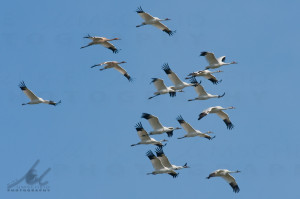
Approximately 50 to 60 percent of the whooping cranes have departed from Aransas Refuge (Texas coast) on their long 2,500 mile migration to Wood Buffalo National Park in Canada. Wood Buffalo is where they nest and rear their young. Dr. Wade Harrell, U.S. Whooping Crane Recovery Coordinator continually monitors the whooper flock on Aransas National Wildlife Refuge. Harrell described the ongoing migration of the birds as normal this spring. He explained that, “Whooping cranes are still being observed on the refuge, but the migration is well underway.
Harrell explained that, “As of Monday, April 8, 14 of the telemetry marked birds that we are actively receiving data on were still present on the Texas coast and 21 have begun migration. Based on this information and other observations, it is likely that greater than 50% of the birds in the Aransas/Wood Buffalo flock are currently migrating north. Of the 21 marked whooping cranes currently in migration, 14 are as far north as Nebraska and the Dakotas.”
Harrell estimates that most remaining birds will depart from Aransas Refuge over the next couple weeks. He advised that, “Whoopers are scattered along the migratory path as far north as North Dakota. Though the birds seem to be leaving in mass, they actually have staggered departures and leave in small groups. This is important as it ensures survival of the species. If they were to all leave together and encountered bad weather or some other catastrophic event, it could put the whole flock in jeopardy.” Dr. Harrell’s migration information mirrors information collected by the Whooping Crane Conservation Association (WCCA). Many bird watchers and a variety of citizens observe whooping cranes and report then on WCCA’s web page https://whoopingcrane.com/ .
Anyone who spots a whooper can go the web page and click on Report a Sighting and complete a simple form. WCCA places the information received on a map during the spring and fall migrations. Anyone can keep up with the migration by clicking on https://whoopingcrane.com/migration/ .
Migration Map
WCCA’s Migration Map includes all creditable whooping crane observations from reports received. Each whooper “icon” on the map represents from 1 to 6 birds. Observations have been posted on the Spring Migration 2013 map since mid-March. Importantly, all postings are delayed at least one week to help prevent harassment of the birds. Because the whoopers move frequently during migration, it is highly unlikely that one can use the map to locate the birds.
Whooping Crane Update – Aransas National Wildlife Refuge (summary)
April 12, 2013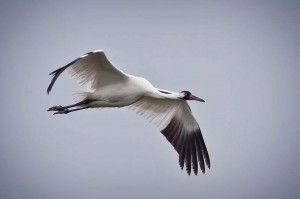 by Wade Harrell, U.S. Whooping Crane Recovery Coordinator
by Wade Harrell, U.S. Whooping Crane Recovery Coordinator
Whooping Cranes on the Refuge:
Birds are still being seen on the refuge, but the whooping crane migration is well underway and we expect that most birds will depart the coast over the next couple weeks. Based on the tracking data and incidental observations, it appears that the birds using the periphery areas of the winter range (i.e. Lamar, Granger Lake, El Campo, Welder Flats) have been the first to depart this year. Though the birds seem to be leaving in mass, they actually have staggered departures and leave in small groups. This is important as it ensures survival of the species. If they were to all leave together and encountered bad weather or some other catastrophic event, it could put the whole flock in jeopardy.
Tracking Efforts:
As of Monday, April 8, 14 of the marked birds that we are actively receiving data on were still present on the coast and 21 have begun migration. Based on this information and other observations, it is likely that greater than 50% of the birds in the Aransas/Wood Buffalo flock are currently migrating north. Of the 21 marked whooping cranes currently in migration, 14 are as far north as Nebraska and the Dakotas
Taking a look into the past as we consider the future:
The following graphic shows the expansion of wintering whooping cranes on and around the Refuge over the past 55 years (1951-2006). As we have seen this winter, this expansion has now moved to a few inland locations such as the Granger lake area. This trend gives us hope that the species will continue on the upward trend. To read the full report, click on: http://www.fws.gov/nwrs/threecolumn.aspx?id=2147517593
Winging it 2,500 Miles to Rear Their Families
March 9, 2013by Chester McConnell, Whooping Crane Conservation Association
Some whooping cranes are heading north. They are departing from Aransas Refuge on the Texas coast. They’re on their way to Canada’s Wood Buffalo nesting grounds 2,500 miles away. Only a small number from the Aransas/Wood Buffalo flock have departed from Aransas but others will soon follow. According to Dr. Wade Harrell, U.S. Whooping Crane Recovery Coordinator: “It appears that some whooping cranes have started to migrate back north, which is several weeks earlier than normal. Perhaps this is not surprising given the unusually warm and dry winter that the southern plains have experienced.”
March brings restlessness to the wintering cranes as days get longer. Cranes of the Aransas/Wood Buffalo flock could encounter dangerous cold and stormy weather if they move north too rapidly. But, whoopers heading to Canada must race for their nesting grounds where summers are short. Adult pairs have to build a nest, lay two eggs and incubate the eggs for 30 days when the chicks hatch. Then they must feed the chicks large amounts of food to get the youngsters ready for the long migration back to Texas. So, whoopers have much to do in a short time on the nesting grounds. Hopefully the northern habitats will be thawed and ready for nesting when they arrive. Most of the Wood Buffalo nesting area is still currently frozen. But whooping cranes are wise and the migration to Canada normally requires 40 to 60 days.
So most likely icy conditions will change before most of the cranes arrive there.Yet, whoopers are definitely in their migration mode. Citizen whooper watchers have reported birds in northern Texas, Oklahoma, Kansas and Nebraska. Eight whoopers were reported as far north as North Platte, Nebraska. Migration records kept by the Whooping Crane Conservation Association indicate about two dozen birds along the migration route. Some of these observations have been verified by U.S. Fish and Wildlife Service refuge managers.
Hopefully all the whooping cranes currently on the way to Canada and those waiting on Aransas Refuge, Texas will have a safe 2,500 mile migration. We know that, sadly, two members of this flock will not be with them. They were shot and killed during the past year, one by a poacher (South Dakota) and the other by a hunter (Texas). Both of the men who killed the whoopers have been prosecuted and received large fines and other punishment. The Whooping Crane Conservation Association urges state and federal wildlife agencies and birding organizations along the migration route to increase their efforts to educate hunters and other citizens about the compelling need to help protect endangered whooping cranes.
Interestingly, Dr. Harrell’s “Wintering Whooping Crane Update” report (3/7/2013) described the movements of one whooper family that has GPS transmitters attached to them: “Update February 24: The marked family group (two adults and one juvenile) from Granger Lake left arriving in North Texas that evening. They stayed through Feb. 28 and then moved to SW Oklahoma where they remained through March 2. They then moved on to Quivira National Wildlife Refuge in South Central KS, a traditional migration stopover site for whooping cranes, where they currently remain.”
More about whooping crane migration can be learned by reading The Whooping Crane Tracking Partnership’s recently issued biannual report. The following is a summary of the data captured from the 2012 breeding season through fall migration (approximately May through November). Background information about the Partnership can be found on the following link: https://whoopingcrane.com/tracking-whooping-cranes-telemetry-update/
Excerpts from the report: “During the 2012-2013 season, information was gathered about location from 36 transmitters during the breeding season and data from 30 transmitters during fall migration. Prior to migration, six transmitters stopped providing data. With the help of the technology, the mortalities of two juveniles and two subadults were confirmed on the breeding grounds of Wood Buffalo National Park. The two other transmitters were confirmed to have broken antenna. The tracking technology also revealed that three cranes spent the summer months in south-central Saskatechewan and 29 marked birds completed the fall migration.”
“The birds began their fall migration from Canada on September 7, 2012, and data indicates that all of the birds arrived on the Texas coast by November 27, 2012. It took the cranes an average of 46 days to make the migration with the migration time ranging from 21 to 67 days. The data shows whooping cranes used 261 different locations where they stopped and stayed for more than one night. Stopover locations occurred in every state and province in the Great Plains. Cranes spent the most time at staging sites in Saskatchewan and the Dakotas. The general migration corridor used was similar to past migrations and there were no mortalities detected during the migration.”
“The GPS tracking devices attached to the whooping cranes are programmed to record four locations daily and provide both daytime and nighttime locations. Transmitters upload data approximately every 2.5 days allowing for monitoring survival. The technology allows biologists to learn which habitats are being used and where the birds stop during their migration – important information when prioritizing management decisions.”
The Whooping Crane Conservation Association supports the Whooping Crane Tracking Partnership’s in hopes that the information they collect will help in the improved management of the whoopers.
Operation Migration On Estimating Whooper Numbers
February 2, 2013Operation Migration’s “In The Field” web page explains, “Debate continues in the Whooping crane world about the methods US Fish and Wildlife Service is now using to count Whooping cranes at the Aransas National Wildlife Refuge.”
“For almost 30 years, retired Whooping Crane Coordinator, Tom Stehn made a direct count of each bird while flying transacts over the refuge. The accuracy of that method was questioned because birds may move between the aircraft passes and been counted more than once.”
“The new system employed since Stehn’s retirement is called ‘distance sampling’. It consists of making multiple parallel survey flights over a large area and applying a formula to the number of cranes spotted to come up with a population estimate.”…
“The concern is that distance sampling is generally used to estimate the size of large populations and there are fewer than 300 Whooping cranes at Aransas. Many feel that a direct count could provide a more accurate number.”
To read the complete article, click on: http://operationmigration.org/InTheField/2013/02/01/controversy-heats-up/
Whooper Nesting Grounds Located (History)
January 2, 2013****History Briefs compiled by Whooping Crane Conservation Association****
Editor Note: For many years no one knew exactly where whooping cranes nested. Until 1954 whooping crane interests only knew that the birds migrated from “somewhere” in Canada to the Texas Coast. Crane interests had watched as the whooper population declined to 16 individuals in 1941. Pressures were brought on government agencies to protect and manage the birds. It was important to locate the whooper nesting habitats so these essential areas could be protected. In 1954 the whooping crane nesting area was finally located. The story is an interesting part of history. Whooping Crane Conservation Association member Pam Bates researched the literature and came across an article published in “Wild Lands Advocate” that tells the story. This is a follow-up to another article on our web page published on December 23, 2012. Click on the following link for the related story: https://whoopingcrane.com/whooping-cranes-from-despair-to-hope-to-progress/
DISCOVERY OF THE NESTING GROUND OF THE WHOOPING CRANE *
by Dr. W. A. Fuller
I have received a lot of credit for the discovery in 1954 of the only whooping cranes in Canada, but if it hadn’t been for the fire and an observant forester named George Wilson, I might never have gone out to identify the birds. The last nest of a whooping
crane had been seen in about 1926 in Saskatchewan. Members of the U.S. Fish and Wildlife Service (USWS) and others had searched from central Saskatchewan to the delta of the Mackenzie River without success. The USWS was interested because whoopers migrated to Texas.In 1945 I spent the summer working on fish in Lake Athabasca. At the end of the summer I decided that I would never return to the north. However, in 1946 I signed up to spend the summer at Great Slave Lake. The following winter I put together all the data that had been gathered over several years on the “Inconnu” (Stenodus leucichthys) and submitted the result as my masters thesis for the University of Saskatchewan. Convocation took place in early May.
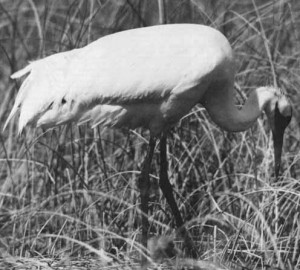
Whooping crane. (From a 1982 Hinterland Who’s Who brochure on the Whooping Crane written by E. Kuyt and published by the Canadian Wildlife Service)
A few days after the ceremony, I turned 23, and on the last day of May I married the young lady who is still my wife. I had previously applied for one of two jobs advertised by the federal government, and I was approved for the one based in Fort Smith, NWT. I found the north gets under your skin, and my wife Marie and I landed in Fort Smith on June 5. My duties centred on mammals in the south half of the Mackenzie District and in Wood Buffalo National Park (WBNP), part of which is in Alberta.In those days, the United States sent a bird guy, Bob Smith, and an assistant down to the Arctic Ocean. They flew out of Fort Smith for two or three days, and I usually took them up on their invitations to go on their sorties. Bob was a great guy, as well as a good pilot and a good bird man. Although waterfowl were the main target, they kept their eyes open for other birds, such as whooping cranes. As late as 1954 they had not made a sure discovery of whoopers, although on an earlier flight with them, one thought he had spotted a crane, but by the time Bob swung the plane around, whatever had been seen had disappeared.
In June 1954, a fire broke out in the northern part of Wood Buffalo Park. On June 30, the fire crew radioed to Fort Smith that one of their pumps was out of order. The forestry guy, George Wilson, went out to the site of the fire in a whirlybird piloted by Don Landells. I was in my office around 4:00 p.m. when a message came in from the plane to the effect that George and Don had seen a few big white birds, which they suspected were whooping cranes. Furthermore, Landells was to make another trip on the same route with a new pump, and if Bill Fuller was at the landing spot at 5:00 p.m he. could go back with Don and the pump.
Bill Fuller was at the landing and ready to go at 5:00 p.m. Don took us back on about the same route he had flown earlier, and we did see some large white birds, which were certainly whoopers. There were young birds as well as adults, so there was reason to believe that the nesting grounds were not too far away. I think we saw about nine birds on that first trip. I sent a telegram to the head office in Ottawa later that evening.
Ottawa’s reply the next morning asked me to keep an eye on the birds whenever there was a chance. I made several trips on an ordinary prop plane. On one such trip I counted thirteen birds, which was just over half of the birds (21, I think) counted in the Texas flock at that time.
The Whooping Crane Society and the USWS were very excited about the discovery, and soon there was talk about a ground survey in 1955. Canadian and American scientists would carry it out. However, the Canadian Wildlife Service (CWS) did not want to commit to that until there was proof of nesting, so I was to take a look next spring as early and as often as possible.
In those days, light aircraft landed on skis in winter and on pontoons in summer. The changeover was made in Edmonton in spring and fall, so it was difficult to find tansportation just when I needed it. While our government plane was in Edmonton, I got a ride with a pilot from Yellowknife on his way to Edmonton.I got another ride in a plane owned by the RCMP in Fort Smith. On that flight I saw what could only be a crane sitting on a nest. So the ground survey was on. Robert P. Allen of the National Audubon Society was to lead it. When Allen arrived in Fort Smith, we made one flight over the area so I could show him the location of the known nests.
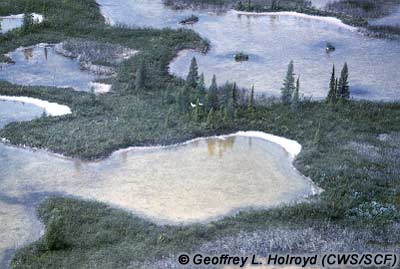
The nesting habitat of the Whooping Crane consists of marshes, shallow ponds, small creeks, and patches of wooded terrain and shrubs. Note two whooping cranes in the center of the photograph.
I made other flights, and I think I found a few more nest sites, but when the ground survey came on, I was at a conference in Alaska. The attempted ground survey is a story of its own.In 1956 I moved to Whitehorse in the Yukon, and Ernie Kuyt of the CWS took over work on the cranes. I had flown over the region of the first sightings a number of times. I had noted the tracks in the mud and searched my brains for a mammal that would make such a trail in the soft mud of the lake bottoms. Big birds never crossed my mind until I saw the cranes there in 1955.So who discovered the nesting ground? Wilson and Landells, who saw the big white birds? Me, because I saw young birds as well as mature birds on my sorties in 1955 and was also the first to see a female on a nest in the spring of 1956?It doesn’t really matter. The important point is that an important nesting ground was found. Each year for several more years, Ernie Kuyt found new nests. The total number of cranes in the Texas/WBNP flock has continued to increase in most, if not all, years since 1955.b
* Published in Wild Lands Advocate, The Alberta Wilderness Association, December 2004 • Vol.12, No. 6, pages 16 and 17.
